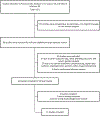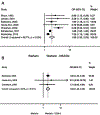Risk of Bleeding with Exposure to Warfarin and Nonsteroidal Anti-Inflammatory Drugs: A Systematic Review and Meta-Analysis
- PMID: 32455439
- PMCID: PMC7665225
- DOI: 10.1055/s-0040-1710592
Risk of Bleeding with Exposure to Warfarin and Nonsteroidal Anti-Inflammatory Drugs: A Systematic Review and Meta-Analysis
Abstract
Background: Warfarin use can trigger the occurrence of bleeding independently or as a result of a drug-drug interaction when used in combination with nonsteroidal anti-inflammatory drugs (NSAIDs).
Objectives: This article examines the risk of bleeding in individuals exposed to concomitant warfarin and NSAID compared with those taking warfarin alone (Prospero Registry ID 145237).
Methods: PubMed, EMBASE, Scopus, and Web of Science were searched. The primary outcome of interest was gastrointestinal bleeding and general bleeding. Summary effects were calculated to estimate average treatment effect using random effects models. Heterogeneity was assessed using Cochran's Q and I 2. Risk of bias was also assessed using the Agency for Healthcare Research and Quality bias assessment tool.
Results: A total of 651 studies were identified, of which 11 studies met inclusion criteria for meta-analysis. The odds ratio (OR) for gastrointestinal bleeding when exposed to warfarin and an NSAID was 1.98 (95% confidence interval [CI]: 1.55-2.53). The risk of gastrointestinal bleeding was also significantly elevated with exposure to a COX-2 inhibitor and warfarin relative to warfarin alone (OR = 1.90, 95% CI: 1.46-2.46). There was an increased risk of general bleeding with the combination of warfarin with NSAIDs (OR = 1.58, 95% CI: 1.18-2.12) or COX-2 inhibitors (OR = 1.54, 95% CI: 0.86-2.78) compared with warfarin alone.
Conclusion: Risk of bleeding is significantly increased among persons taking warfarin and a NSAID or COX-2 inhibitor together as compared with taking warfarin alone. It is important to caution patients about taking these medications in combination.
Georg Thieme Verlag KG Stuttgart · New York.
Conflict of interest statement
None declared.
Figures



Comment in
-
Navigating NSAID Use in Patients Receiving Oral Anticoagulation: Is There a Safe Course?Thromb Haemost. 2020 Jul;120(7):1001-1003. doi: 10.1055/s-0040-1713098. Epub 2020 Jul 6. Thromb Haemost. 2020. PMID: 32629493 No abstract available.
Similar articles
-
Gastrointestinal safety of nonsteroidal antiinflammatory drugs and selective cyclooxygenase-2 inhibitors in patients on warfarin.Ann Pharmacother. 2009 Nov;43(11):1765-73. doi: 10.1345/aph.1M284. Epub 2009 Oct 6. Ann Pharmacother. 2009. PMID: 19809010
-
Concomitant Oral Anticoagulant and Nonsteroidal Anti-Inflammatory Drug Therapy in Patients With Atrial Fibrillation.J Am Coll Cardiol. 2018 Jul 17;72(3):255-267. doi: 10.1016/j.jacc.2018.04.063. Epub 2018 Jul 9. J Am Coll Cardiol. 2018. PMID: 30012318 Clinical Trial.
-
Effect of proton-pump inhibitors on the risk of lower gastrointestinal bleeding associated with NSAIDs, aspirin, clopidogrel, and warfarin.J Gastroenterol. 2015 Nov;50(11):1079-86. doi: 10.1007/s00535-015-1055-2. Epub 2015 Feb 21. J Gastroenterol. 2015. PMID: 25700638
-
Association of Antisecretory Drugs with Upper Gastrointestinal Bleeding in Patients Using Oral Anticoagulants: A Systematic Review and Meta-Analysis.Am J Med. 2022 Oct;135(10):1231-1243.e8. doi: 10.1016/j.amjmed.2022.05.031. Epub 2022 Jun 7. Am J Med. 2022. PMID: 35679879 Free PMC article.
-
Management of Anticoagulants and Antiplatelet Agents During Colonoscopy.Am J Med. 2017 Jul;130(7):786-795. doi: 10.1016/j.amjmed.2017.01.052. Epub 2017 Mar 24. Am J Med. 2017. PMID: 28344132 Review.
Cited by
-
Comparing the Efficacy and Safety of Apixaban Versus Warfarin in Morbidly Obese Patients.Cureus. 2022 Oct 14;14(10):e30303. doi: 10.7759/cureus.30303. eCollection 2022 Oct. Cureus. 2022. PMID: 36407232 Free PMC article.
-
Real-World Bleeding Risk of Anticoagulant and Nonsteroidal Anti-inflammatory Drugs Combotherapy versus Anticoagulant Monotherapy.Gut Liver. 2024 Sep 15;18(5):824-833. doi: 10.5009/gnl230541. Epub 2024 May 10. Gut Liver. 2024. PMID: 38726558 Free PMC article.
-
The anti-inflammatory and analgesic activities of 2Br-Crebanine and Stephanine from Stephania yunnanenses H. S.Lo.Front Pharmacol. 2023 Jan 4;13:1092583. doi: 10.3389/fphar.2022.1092583. eCollection 2022. Front Pharmacol. 2023. PMID: 36686697 Free PMC article.
-
Clinical Implications of Polypharmacy for Patients with New-Onset Atrial Fibrillation Based on Real-World Data: Observations from the Korea National Health Insurance Service Data.Rev Cardiovasc Med. 2024 May 11;25(5):164. doi: 10.31083/j.rcm2505164. eCollection 2024 May. Rev Cardiovasc Med. 2024. PMID: 39076479 Free PMC article.
-
Prevalence of potential drug - drug interactions in the cardiothoracic intensive care unit patients in a Chinese tertiary care teaching hospital.BMC Pharmacol Toxicol. 2022 Jun 14;23(1):39. doi: 10.1186/s40360-022-00582-6. BMC Pharmacol Toxicol. 2022. PMID: 35701808 Free PMC article.
References
-
- Heneghan C, Alonso-Coello P, Garcia-Alamino JM, Perera R, Meats E, Glasziou P. Self-monitoring of oral anticoagulation: a systematic review and meta-analysis. Lancet 2006;367(9508):404–411 - PubMed
-
- Keeling D, Baglin T, Tait C, et al. Guidelines on oral anticoagulation with warfarin – fourth edition. Br J Haematol 2011;154(03):311–324 - PubMed
Publication types
MeSH terms
Substances
Grants and funding
LinkOut - more resources
Full Text Sources
Medical
Research Materials
Miscellaneous

